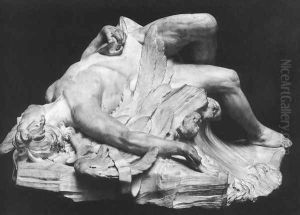Paul-Ambroise Slodtz Paintings
Paul-Ambroise Slodtz was a French sculptor born in Paris in 1702. He was part of the prominent Slodtz family, which included several well-known artists of the time. His brothers, René-Michel, known as Michel-Ange, and Sébastien-Antoine were also acclaimed sculptors. This artistic lineage provided a fertile ground for Slodtz's development as an artist.
Slodtz was initially trained by his father, Sébastien Slodtz, who was a sculptor of Dutch origin. Under his father’s tutelage, he gained a strong foundation in the arts, which was further enhanced by his studies at the prestigious Académie Royale de Peinture et de Sculpture in Paris. His talent was recognized early on, and he won the coveted Prix de Rome in 1726, which allowed him to study at the French Academy in Rome.
During his time in Rome, Slodtz was heavily influenced by the baroque style, which was characterized by dramatic expression, rich detailing, and dynamic movement. He studied the works of masters such as Gian Lorenzo Bernini and integrated aspects of their style into his own work. After returning to Paris, Slodtz became a member of the Académie Royale and received commissions from the royal court and the Catholic Church, which were the main patrons of the arts during this period.
Slodtz's works are known for their technical skill and emotional intensity. He was adept at carving marble and had a particular talent for capturing the textures of skin and cloth. One of his most famous works is the tomb of Cardinal Fleury in the Church of Saint-Germain-des-Prés in Paris, which showcases his mastery in portraying the human form and his ability to imbue stone with a sense of vitality and expression.
Despite his success, Slodtz's life was relatively short. He died in 1758, at the age of 56. His legacy, however, endured, and he is remembered as one of the significant French sculptors of the 18th century. Slodtz's work bridged the gap between the late Baroque and the emerging Rococo style, and his influence can be seen in the works of subsequent generations of French artists.
